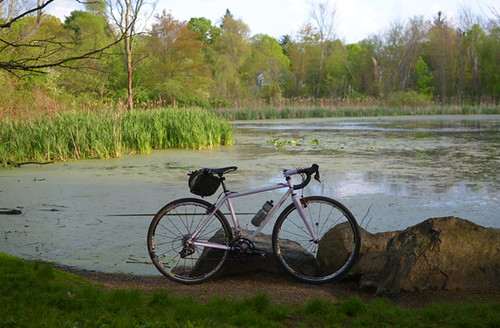
When a bicycle leaves you at a loss for words, is that a good thing? With hundreds of miles now on this Honey Cyclocross demo bike, I am leaning toward yes. Because I'm not exactly itching to give it back.
Last summer I was briefly without a suitable bike for dirt and gravel. When a local unpaved ride came around, a buddy lent me her Honey Cyclocross racing bike. I wrote about that bike here, then rode the Kearsarge Klassic on it successfully. And that should have been that. But months later, even as I happily rode my own bike, memories of that CX Honey kept intruding. In my first impressions write-up I described how "different" its handling felt from anything I'd tried before. As a wannabebicycle designer, this gnawed at me. What was it about that bike?
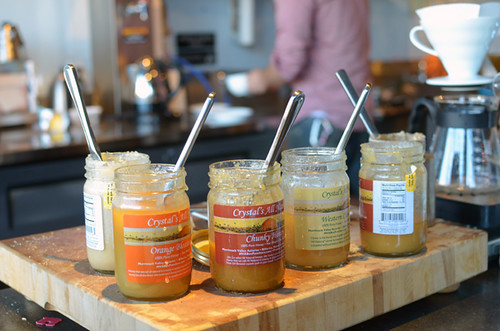
Enter geographical luck of the draw. Honey Bikes are local to me, theproject of Rob Vandermark whom I know through the Ride Studio Cafe bicycle shop andSeven Cycles. Last Fall, we had occasion to talk about the cyclocross bike I'd tried, and I struggled to articulate why I found its handling so "different."
At this time, a batch of Honey demo bikes was being prepared for the Ride Studio Cafe, and one of them was set up for me. The idea was along-term test ride and review:I would ride the bike until it became familiar, allowing me to articulate what I found so striking about its handling.In particular, we discussed how appropriate a bike like it might be for long unpaved rides, and how it compared to the 650B low trail model I was comfortable with.
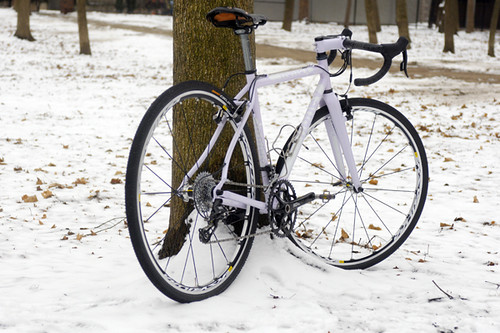
The bike arrived just as a series of snow storms hit the Northeast, which made for some appropriate pictures of the "winter lilac" colour.
I should note here that the bicycle reviewed here is completely stock in everything from size and geometry to component group and finish. Honey bikes are not custom, but made-to-order stock bikes, available in a variety of sizes and option packages. This production method allows them to keep prices in the $2,400-4,000 range for complete bikes, and to offer quick turn-around. The bicycles are steel, with carbon fiber forks (though steel forks are also available). Models include road, utility, mixed terrain, mountain, cyclocross and more. All frames are handmade in the USA, the current series produced by Seven Cycles in Watertown, MA.
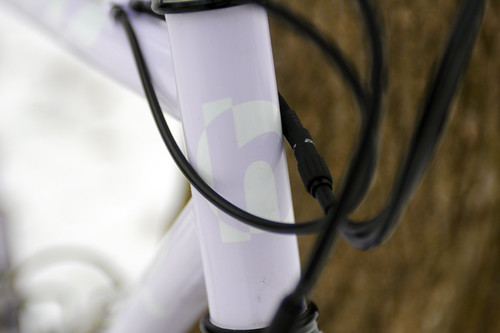
Honey bikes are offered in two types of finishes. The standard finishesare tone-on-tone, and so subtle that the logos and other markings are virtually invisible unless you stand inches from the bike or intentionally bump up the contrast in pictures to draw them out.For those who prefer a finish with visible logos, Honey also makes"team" finishes, where the panels and lettering contrast the main colour.
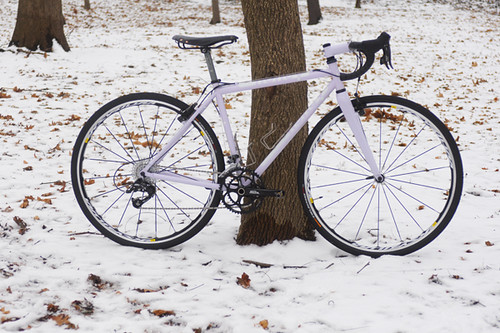
Like the bike I had borrowed last summer, this is a stock 52.5cm Honey Cyclocross race frame (they also have a utility cross model, but this is not it). The sizing figures on Honey bikes refer to the virtual top tube length. Because this bike was set up for me from the get-go, it fit me much better than the one I rode previously. The handlebar height and width, the stem length, and the saddle position were configured with my fit in mind. The brakes were routed right=front, the way I set up my own. When I got on the bike, everything immediately felt natural, and there is a lot to be said for this. With roadbike test rides, fit really matters.

The Honey was set up with a SRAM Rival group and TRP mini-v brakes. The brakes work excellently (more on that here), which was a great relief from previous experiences with cantis. And while I have a Campagnolo setup on my own bikes, I am also comfortable with SRAM levers and have no problem switching back and forth between the two systems.

As I see it, going with SRAM on a bicycle like this has several benefits. The main one, is that SRAM now makes it possible to use low gears with a road drivetrain and modern integrated shifters. Their new wifli system, despite the silly name, is extremely useful in that it allows for a 12-32t cassette. Paired with a 50/34t crankset, that almost gives you a 1:1 low gear, without having to do anything unconventional to the drivetrain. Unofficially, I am told that the wifli derailleur will also handle a 34t cog from a mountain or touring cassette, but I wanted to ride the bike with everything stock before trying out-of-spec configurations. As is, the SRAM Rival drivetrain has been functioning flawlessly ...which brings me to the other benefit - the value. While I love the feel of Campagnolo Chorus, I've been disappointed with their lower-end groups in the past couple of years. At the lower to mid range, I have to admit that SRAM groups feel nicer. In particular, I find Rival to be the sweet spot as far as cost to performance ratio.
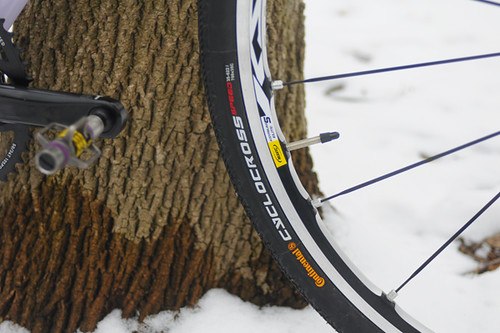
The bike is fitted with Mavic Ksyrium Elite wheels and Continental Cyclocross Speed tires, 700Cx35mm. The tires were chosen for their versatility: The tread can handle most unpaved terrain, without slowing the bike down too much on pavement. I have found this useful.Off pavement, I feel comfortable with these tires on dirt, gravel, reasonably shallow sand and not-too-thick mud. On pavement, I do find them slower than slick road tires, but it's not too bad and I don't mind working a little harder on paved sections. These tires are also great in the rain and light snow. In bad weather, I find myself reaching for this bike.
Speaking of snow... Though I did not ride a lot over this past winter, the little riding I did was mostly on the Honey. Partly this was due to the tires: They handled unexpected patches of ice and snow on the road better than the tires on my own bikes. But partly it was also the handling. I will get more into this later, but when I got the demo Honey, fitted to my riding position, my first impression was that it felt like a toy - I was compelled to try stuff on it that I had not done on other bikes - like jumping over things and riding in snow. So I did, until eventually I crashed into a tree riding in the woods. My leg and hip were covered in bruises that took weeks to heal, but luckily the bike was fine!
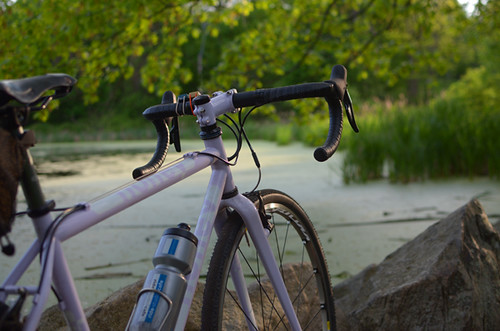
Spring took a long time arriving this year. But finally by mid-March I started putting in some proper miles. As a way of ensuring I get used to the Honey's handling, for some time I rode it exclusively: Group rides, solo rides, paved rides, dirt rides, short rides, long rides - for 3 weeks straight it was all Honey, all the time. After that, I began riding my own bikes again (skinny tire road and fat tire dirt), alternating between the Honey and them.
For some time, I marveled at the handling every time I got on this bicycle. I am going to use experiential terms here. One term that comes to mind is "hyper hip-steerable." Maybe even "rear wheel drive." That is, the bike struck me as overly sensitive to movement at the hips, to the point that it almost felt like the front end was controlled from the back. For instance, let's say I was behind a rider and wanted to pass them. On this bike, I discovered a maneuver, where I could flick my hips ever so slightly while accelerating and "slingshot" past the rider in front of me in a tight, perfectly controlled arc. Maybe that sounds crazy, or maybe this is something everyone but me has been doing all along, I can never tell. In any case, it's easy and intuitive to do on this bike.
But unless I intentionally fling it sideways, the bike has a "tracks straight" feel to it at all speeds. Even when walking it I can feel this: Using the gentlest touch, I can easily steer it by the back of the saddle and the front won't turn or flop to the side. Riding it at excruciatingly slow speeds is easy as well; it really "wants to stay upright" and go straight.
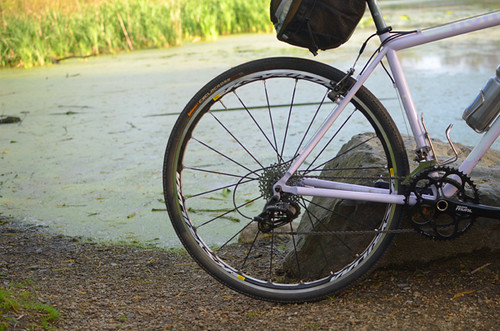
Hopping over bumps, rocks and roots is unusually easy. The first time it happened, I simply saw a huge root in front of me, and before I knew it my front wheel was sailing over it and landing on the other side. I was not conscious of having pulled up on the handlebars. I can now hop over objects on other bikes too, but it takes more effort.
On descents, initially I found that I could not easily turn and maneuver this bike using the same approach as on others I've ridden. But I quickly learned that changing my balance over the saddle made it controllable in these situations. I still do not understand this part entirely, but my subjective feel is that I almost hang off the bike to the side in order to steer it on turns. Possibly, this is my way of compensating for not being able to lean the bike itself sufficiently.
All the characteristics described become less noticeable the more I ride the bike. But if I go even as much as a week without riding it, I immediately notice them again when switching from my own bicycles. It's not a matter of better or worse, but just a "Hey, this is different!" kind of feeling every time.
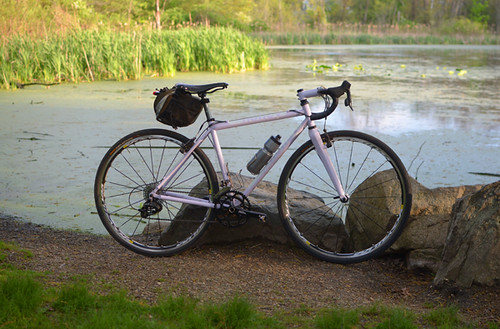
The aesthetics of the Honey Cyclocross bike are modern and sporty: thick tubes, unabashedly sloping top tube, straight fork. This look is growing on me - or maybe a more accurate way to put it would be "I appreciate it for what it is." I do love the winter lilac finish.The welds are very smooth, more or less invisible under the paint. And the overall look has a unity and harmony to it that makes sense to me visually.
The tubing is oversized and thin-walled. Pinging it with my fingernail, there is a distinct hollow ring. Riding the bike, it feels extremely stiff - though not in a disagreeable way. It feels light in motion, fast to accelerate, ever-ready and ever-awake. Despite the stiffness, the ride is not harsh. The jury is still out on the relationship between flex and responsiveness to pedaling effort, and I won't attempt to make any connection here. I will only say that I enjoy how stiff this bike feels.
I intentionally did not look at the geometry in advance, so as not to bias my impressions. When I did have a look later, I did not see anything too unusual. Longer chainstays and less bottom bracket drop than typical with road geometry; slightly higher trail. None of it seemed sufficiently dramatic to explain my strong reaction to the bike. Maybe it's one of those "the whole is greater than the sum of its parts" things. There is, after all, a lot I don't understand about bicycle design.
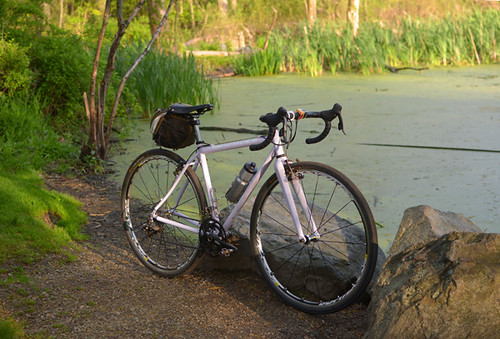
The one word I would use to describe the Honey Cyclocross bike is "fun." As in exciting, playful, toy-like. This bike really moves, and under a more skillful rider than me I am sure it would move even better. While I am obviously not evaluating it in that context, I can see how a bike like this would make a good choice for racing cyclocross.
As far as unpaved brevets and such, I think the CX Honey could work nicely for those who want a lightweight, modern, racy bike with wide 700C tires. Although designed for short races, to me it feels great over 100K distances. The main thing, is that after hours in the saddle I find it delightfully non-fatiguing.
Not being a utility bike; this particular Honey model is not built for racks or carrying heavy loads. Riding it with a full, wide Carradice-style saddlebag in the rear, I can feel the weight (or drag - not sure which). With a smaller bag that tucks under the saddle (like the Dill Pickle shown here) this is considerably less pronounced. I have not tried a bag on the front - though I've now been lent an Ortlieb system to experiment with, and will report back.

Riding this bike on dirt and gravel, I am as fast as I'm capable of being,and reasonably confident riding over most types of terrain I encounter. On pavement, I am slower on the Honey than on my skinny-tire roadbike. And compared to my low trail 650Bx42mm all-steel bike, the Honey is on average about the same both on pavement and dirt. One aspect where they differ, is if I try to seriously push the speed beyond my comfort zone - for instance, in order to keep up with faster riders. When doing this, I can push both bikes pretty hard, but on the Honey I feel less tired afterward. The 5lb difference in the weight of the bikes could account for this, as could the difference in frame and fork materials. On the other hand, when all is said and done I prefer my own bike's front-end handling. It is simply more intuitive to me, and on challenging terrain with twists and turns I am generally more relaxed and precise on it for that reason. Nonetheless, I appreciate the Honey's handling as well. I especially enjoy switching between the bikes and experiencing the difference, adapting to one then another.
It fascinates me to no end how two bikes can excel at the same task, yet ride and feel so differently.I will elaborate on this shortly, but recently I began working with Rob Vandermark on a special project. My experience with the CX Honey - in conjunction with my own bike - has been particularly educational in that context.
With unpaved riding increasingly popular, it's exciting to have choices for go-fast bikes with fat tires. The Honey Cyclocross bike is certainly worth considering - fast, fun, made in Massachusetts, and reasonably priced with lots of sizing options. It's been a pleasure getting to know this bicycle, improving my handling skills and expanding my horizons in the process.
No comments:
Post a Comment